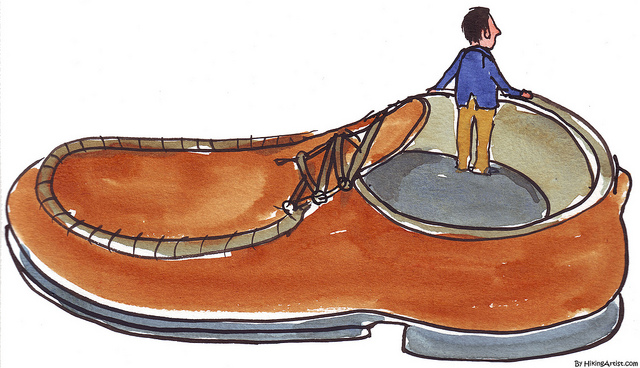|
|
|
Monday, December 16th, 2019

Poking through 11+ years of posts I find information that’s as useful now as when it was written.
Golden Oldies is a collection of the most relevant and timeless posts during that time.
Our population is aging, so more and more products are being developed for that market. The problem is that they are being developed by 20 and 30-somethings based on their idea of what’s needed — but in most cases they don’t have a clue.
Read other Golden Oldies here.
How would you respond to the following if you a large segment of your target market was older?
-
- Would you hire a woman?
- Would you hire an old woman?
- A really old woman?
- Could such a woman contribute significantly to a project?
- What could she teach your hot, young engineers?
While most founders would answer ‘no’ or ‘nothing’, IDEO thinks differently.
The company recently hired Barbara Beskind and both she and IDEO consider her 90 years a major advantage.
She applied after seeing an interview with IDEO founder David Kelley, who talked about the importance of a truly diverse design team and hires accordingly.
The aging Boomer market has companies salivating and hundreds are developing products for them.
The problem, of course, is that younger designers have no idea what difficulties older people face; not the obvious ones, but those that are more subtle.
Beskind does.
For example, IDEO is working with a Japanese company on glasses to replace bifocals. With a simple hand gesture, the glasses will turn from the farsighted prescription to the nearsighted one. Initially, the designers wanted to put small changeable batteries in the new glasses. Beskind pointed out to them that old fingers are not that nimble.
“It really caused the design team to reflect.” They realized they could design the glasses in a way that avoided the battery problem.
It’s the little things that make or break products and the knowledge of the little things comes mostly from having been there/done that.
That kind of insight is priceless.
Now how would you answer those questions?
Image credit: jm3 on Flickr
Posted in Golden Oldies, Hiring | No Comments »
Monday, December 2nd, 2019

Poking through 11+ years of posts I find information that’s as useful now as when it was written.
Golden Oldies is a collection of the most relevant and timeless posts during that time.
This post is from 2014, but layoffs are again in the news. Almost every day another company talks about cost-cutting and rumors start to fly. Contrary to what you might think, there is a right way and a wrong way to handle a layoff.
Read other Golden Oldies here.
A Friday series exploring Startups and the people who make them go. Read all If the Shoe Fits posts here
The need for a layoff can happen to any company of any age or size, but most companies and managers bumble the task and end up doing far more damage than necessary.
The damage is not just to those laid off, but also to those left behind, themselves and the company.
As most of you have read, Cheezburger Networker just laid off a third of its staff, but great credit goes to CEO Ben Huh for bending over backwards to do it with the least damage possible.
-
- He cut his vacation short when he realized what had to be done, as opposed to delegating it and staying away until it was over.
- He was honest, open and candid with his entire staff, thus avoiding the kind of rumors that typically circulate.
- He did everything possible to ensure those laid off found new positions, including personally reaching out to other companies and setting up his own job fair.
In short, he did everything I recommended in 2008.
I only know of one manager who got his jollies laying people off (he always tried to do it just before Thanksgiving or Christmas) and he was, without doubt, a sadist.
Most managers, like Huh, find them to be tremendously emotional and not at all fun.
“Often, when faced with a problem, you want to run in the other direction. It’s like seeing a lion in the jungle. But I have to do what is best for the company, even if it sucks emotionally.”
There’s one more required action after a layoff and that’s dealing with the empty space, which can’t be ignored, but can be done positively without spending big bucks.
Image credit: HikingArtist
Posted in Communication, Golden Oldies | No Comments »
Monday, November 25th, 2019

Poking through 13+ years of posts I find information that’s as useful now as when it was written.
Golden Oldies is a collection of the most relevant and timeless posts during that time.
80 years ago Dave Packard commented that good management was “marked by personal involvement, good listening skills and the recognition that “everyone in an organization wants to do a good job.” That belief developed into a management technique called MWBA and it’s just as powerful now as it was then — if not more so. 13 years ago I wrote a four-part series about it. The second post talks about why to do it, the third about uncovering problems and the fourth about using MWBA to crosscheck what you hear.
And yes, you do have time.
Author John le Carré, of Bond fame, said it best.
“A desk is a dangerous place from which to view the world.”
Read other Golden Oldies here.
Remember Management By Walking Around (MWBA)? It’s an oldie, but a goodie.
Great managers work to spend at least 25% (or more) of their time wandering around chatting and building trust with their people.
Don’t have time? Maybe that’s because you never really thought abut the benefits. Getting to know your people this way helps you to
-
- spot high-potential workers;
- raise your trust quotient with employees;
- improve retention;
- attract talent;
- discover molehills before they’re mountains, and, most importantly, it’s the best, if not only, way to
- know what’s really going on.
To work it must be the norm—that means it needs to be done constantly, not just when there’s a problem.
Consistent, casual visits make people feel comfortable and encourages them to chat—saying what they are thinking without editing it. To pass on information, rumors, and the like without wondering or worrying that it will boomerang and hurt them.
While wandering, you’ll hear enough to validate or repudiate what you heard from somewhere else. It lets you protect your sources—which means they’ll continue to pass on information—and it helps you avoid acting on erroneous information.
The higher you rise in the organization the more important this intelligence becomes. One of the greatest dangers for any manager is getting isolated and hearing only a sanitized or slanted version of what’s going on within the group, department or company. This is especially true for the CEO and senior staff.
Bottom-line—get off your duff, out of your office, wander around, say hi, listen, be a sponge and soak it all up.
Invest the time—that’s what managers do—and it will pay off handsomely!
Does it still work? Absolutely. Read about how it went from strictly a management tool to also offering personal growth and stress reduction.
A note for managers in love with tech. MBWA can’t be done digitally; it’s an in-person, face-to-face technique that works.
It takes far less time than recruiting new people.
And it’s free.
Image credit: LYCS Architecture on Unsplash
Posted in Communication, Culture, Golden Oldies, Leadership, Retention | No Comments »
Monday, September 16th, 2019

Poking through 11+ years of posts I find information that’s as useful now as when it was written.
Golden Oldies is a collection of the most relevant and timeless posts during that time.
How time and tech fly. I wrote this in 2017 and there’s been a lot of change since then. In short, while hypocrisy has skyrocketed, with the advent of Uber, Lyft, We, and others profitability has fallen way behind. Greed, however, is alive and kicking butt — think We’s Adam Neumann.
Read other Golden Oldies here.
A Friday series exploring Startups and the people who make them go. Read all If the Shoe Fits posts here.
Tuesday I cited a post by Scott Belsky on Medium talking about how employees are often conned (my word) by founders, especially unicorns, when it comes to the wealth that is supposed to flow from their ISO.
As pithy as the post was, some of the comments were even pithier. I especially like this one from colorfulfool (21st comment)
If profitability were proportional to hypocrisy, there would be no failed startups in the Valley.
Not just true, but succinctly and elegantly stated.
Founders love to talk about the importance of transparency, trust and authenticity.
However, their stock plans and pitfalls thereof exhibit such a high degree of opaqueness and caveat emptor that they kick a hole the size of Texas in the fabric of the founders’ authenticity.
Another prevalent piece of hypocrisy is “change the world.”
Do you really believe that another dating app or being able to evaluate a new restaurant or another way to buy your groceries will change the world?
While they may impact one’s personal world, they certainly don’t have the impact of something like Mine Kafon.
What is proportional to the Valley’s hypocrisy is its sheer greed.
Actually, when I stop to think about it, the greed probably exceeds even the hypocrisy.
Image credit: HikingArtist
Posted in Compensation, Culture, Entrepreneurs, If the Shoe Fits | No Comments »
Tuesday, May 21st, 2019

Back in 2015 I wrote about the importance of living your own life, instead of trying to live someone else’s as seen on Instagram. Last month we considered the idea that it is our values that are the basis of true authenticity and yesterday the lesson was that mea culpa was valueless if it wasn’t sincere, AKA, authentic.
Given all that, what do you do when you
- know you messed up; and
- are incapable of admitting it?
Gurus of whatever type love to apply the 80/20 rule to situations like this, meaning that once you know/understand the problem (80%) then applying a solution is relatively easy (20%), so just do it.
Which, based on all I’ve seen and my own personal experience, is bunk.
If there’s anything I’ve learned in my life it’s that one size or solution does not fit all.
What do you do when you know you should take responsibility and just can’t make yourself do it?
Let’s start with what you don’t do.
You don’t
- shift the blame (responsibility) to another person or the group;
- pretend it didn’t happen; or
- act oblivious.
Doing the first will turn your people against you; either of the others will make you look like an idiot — and turn people against you.
So what do you do?
Discuss the problem/situation openly, tacitly admitting the source by not specifying it and encouraging the team to provide solutions, as opposed to you.
Your people aren’t stupid or you wouldn’t have hired them.
They’ll understand your actions giving you time to change your MAP, so you can admit it openly the next time — because there will always be a next time.
Image credit: Bill Ohl
Posted in Communication, Culture, Personal Growth | 1 Comment »
Monday, May 20th, 2019

Poking through 12+ years of posts I find information that’s as useful now as when it was written.
Golden Oldies is a collection of the most relevant and timeless posts during that time.
Mea culpa has never been anyone’s favorite thing, but in the eight years since I wrote this post hearing it has become even more unlikely — unless, of course, the speaker has already been outed for whatever and mea culpa is their default fallback position/excuse.
Read other Golden Oldies here.
In the popular vernacular, the expression “mea culpa” is an admission of having made a mistake by one’s own fault (one that could have been avoided if the person had been more diligent).
Mea culpa are two of the most powerful words any manager can say—as long as they are authentic.
Creating a culture where mea culpa is not just tolerated, but applauded is the mark of the best ‘leadagers’ (Leader + Manager discussion).
The words offer no value if they are uttered insincerely or as a means to an end.
Publicly taking responsibility for an error, let alone a real screw-up, is the mark of a good leader, a great manager and a true mensch.
How often have you said ‘mea culpa’ and meant it?
Image credit: Markus Tacker
Posted in Culture, Golden Oldies, Personal Growth | 1 Comment »
Friday, April 5th, 2019

A Friday series exploring Startups and the people who make them go. Read all If the Shoe Fits posts here.
Last Friday we looked at how culture is based on values and how often the values claimed aren’t, in fact, authentic.
Values are one thing, but the whole authentic idea is overblown.
How many times have you heard “bring your authentic self to work (or wherever).
If you’re like most people you have multiple authentic selves.
Think about it, the self you show your spouse is different than the self you show your boss and both are different from the self your friends know.
Yet they are all authentic.
Meaning each self adheres to the same values.
For example, if one self is married and another self has a lover both selves are authentic, since their basic value system accepts cheating.
Look around, not just at the people you’re close to or see frequently, but at the names you see in the news.
Compare what they say/do in various situations and you’ll find you can figure out very quickly what their real authentic values are.
Image credit: HikingArtist
Posted in Culture, Entrepreneurs, If the Shoe Fits, Personal Growth | No Comments »
Friday, March 29th, 2019

A Friday series exploring Startups and the people who make them go. Read all If the Shoe Fits posts here.
Pundits and investors of all kinds, from lone angels to major VCs, say that your company’s culture is critical to its success.
Therefore, the most important question founders should ask themselves is what are my values?
Not what you say out loud, or agree to in order to fit in, or because they are good talking points, or to be PC.
You need to be brutally honest, at least with yourself, because, in the long run, whatever your values truly are will out.
Mark Zuckerberg claimed he wanted to do good by connecting people.
Larry Page and Sergey Brin wanted to organize the world’s information and “not be evil.”
But, in the long run, their top core value became obvious, echoing Gordon Geko’s, “Greed is good.”
Also long term, Andrew Wilkinson’s 2015 words reflect his values, I’m not a unicorn, I’m a horse.
Culture is based on founder values and sooner or later the real ones do surface.
This is where being “your authentic self” trips up a lot of people, not just founders.
Image credit: HikingArtist
Posted in Culture, Entrepreneurs, Ethics, If the Shoe Fits | No Comments »
Wednesday, January 30th, 2019

I especially like this post because, in today’s build-your-brand culture, it presents a solid road to success as a boss based on a radical idea: it’s not about you. You are not the be-all and end-all and even if you were it wouldn’t make you a success as a boss. It’s why, in the long run, AI won’t/can’t replace human bosses.
I joined the Marines right out of high school and started in business before I earned my degree. I had a family to support, so going the traditional student route made little sense. I earned my degree while I also worked full-time at responsible jobs. It turned out to be a good thing.
I could take classroom learning and try it on the job right away. It didn’t take long to figure out that an awful lot of the so-called expert advice was nonsense. The people in my economics textbooks, for example, didn’t act like me or any people I knew. Years later, Nobel Laureate Richard Thaler would call them “econs.”
Most of my books and most of my professors treated management as an engineering problem. There was much language about designing an effective system and “well-oiled machines.” There was plenty of advice that involved knowing what buttons to push or what levers to pull.
I learned a lot of good things, but most of the good stuff had nothing to do with working with people. I learned most of that on my own, mostly the hard way. You can have the biggest brain on Planet Earth but working with people requires your heart.
Working with people differs from working with machines. You don’t have to read a book or this blog post to figure this out. Look around you. Think about the people you work with every day.
What are People Like?
We know a lot about people. For starters, we know that we’re all imperfect. We make mistakes. That includes you. Forgive other people when they make a mistake. Admit it when you do.
People have strengths and weaknesses. You want to get the most you can out of those strengths and make those weaknesses irrelevant. People want to make progress. You should help them improve performance and spot opportunities they can seize.
People are emotional. Your computer doesn’t care if you snap at it, but your teammates do. A turret lathe won’t have a fight at home before coming to work. But pretty much everyone I know has had that experience. That’s how it is. Deal with it.
Machines can run all day, every day, for months. Buildings can last for decades with little maintenance. People are different. There’s a limit to how many hours most people can put in before productivity dwindles to almost nothing. For most of us, the top limit is somewhere between 50-55 hours a week. Overwork your people and their productivity will drop like a stone.
People need recovery time, too. After a long day, or after that big push to get a project done, people need to take time off. They need to hang out with their friends, play with their kids, go to a baseball game, or cook and consume a fine meal. Anything that’s not work-related. You interrupt that recovery time at your peril. Do it too often and people get resentful.
People thrive on good relationships. People want to work with other people they enjoy and that they can count on. Many a team has seen productivity decline because two team members couldn’t or wouldn’t get along. It’s your job to manage the work environment.
You’re A People, Too
You’re a person, too. You make mistakes. You have emotions. You have strengths and weaknesses. You want to make progress. Relationships matter a lot. You need breaks and recovery time.
One more thing. You set the example, whether or not you want to. It’s almost impossible to have a team that’s productive and happy if you’re a grumpy slacker. See to yourself first. Revel in your humanity. Draw strength from your relationships. Work hard, but get recovery time, too.
Image courtesy of Three Star Leadership
Posted in Communication, Leadership, Personal Growth, Retention | No Comments »
Monday, December 17th, 2018

Poking through 11+ years of posts I find information that’s as useful now as when it was written.
Golden Oldies is a collection of the most relevant and timeless posts during that time.
Are you familiar with tuits? More specifically round tuits?
Round tuits are extremely dangerous. They are disappointing, disruptive, and even destructive.
And they don’t just attack in the workplace; they can cause even worse damage in your personal life, as we’ll discover tomorrow.
Read other Golden Oldies here.
Have tuits invaded your team’s culture?
Have they seeped into your personal culture and infected your values?
Tuit culture is insidious; it usually starts with small inconsequential stuff and then quietly spreads.
If not dealt with immediately it can delay projects, impact vendors, damage customer relationships, substantially increase turnover, especially among your best and brightest, and ruin your street rep.
Are you familiar with the warning signs, so you can take action before tuit culture takes root?
Be warned if you notice any of the following:
- Small tasks aren’t done on time or just aren’t done.
- One or more of your team are slow to respond to requests.
- Individuals and teams find ways of bypassing one or more of their members or bosses.
The best antidotes to tuit culture are vigilance, awareness, transparency and open communications.
Image credit: RampUp Solutions
Posted in Communication, Culture, Golden Oldies | 1 Comment »
|
 Subscribe to
Subscribe to
MAPping Company Success
About Miki 
Clarify your exec summary, website, etc.
Have a quick question or just want to chat? Feel free to write or call me at 360.335.8054
The 12 Ingredients of a Fillable Req
CheatSheet for InterviewERS
CheatSheet for InterviewEEs™
Give your mind a rest. Here are 4 quick ways to get rid of kinks, break a logjam or juice your creativity!
Creative mousing
Bubblewrap!
Animal innovation
Brain teaser
The latest disaster is here at home; donate to the East Coast recovery efforts now!
Text REDCROSS to 90999 to make a $10 donation or call 00.733.2767. $10 really really does make a difference and you'll never miss it.
And always donate what you can whenever you can
The following accept cash and in-kind donations: Doctors Without Borders, UNICEF, Red Cross, World Food Program, Save the Children
*/
?>About Miki
About KG
Clarify your exec summary, website, marketing collateral, etc.
Have a question or just want to chat @ no cost? Feel free to write
Download useful assistance now.
Entrepreneurs face difficulties that are hard for most people to imagine, let alone understand. You can find anonymous help and connections that do understand at 7 cups of tea.
Crises never end.
$10 really does make a difference and you’ll never miss it,
while $10 a month has exponential power.
Always donate what you can whenever you can.
The following accept cash and in-kind donations:
|













